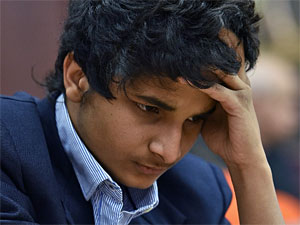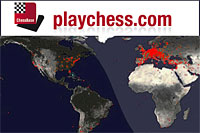
The Chess Academy of Armenia, under the auspices of Armenian Chess Federation, organized the annual “Lake Sevan 2015” International Chess Tournament from 11 to 21 July, 2015 in Martuni, Armenia. It was a FIDE category 15 ten player round-robin event with an average Elo of 2617. The games started every day at 3 p.m. local time. Tournament director was GM Smbat Lputian, Chief Arbiter IA Norayr Kalantaryan, time control Fisher Time.
Editorial note: The way in which a 2650 player thinks and feels is quite difficult to understand. There are only 100 such players in the world, and majority of them like to keep things to themselves. Only a few, Vidit Gujrathi being one of them, are ready to share their experiences with the world-wide audience in order to enrich their understanding of the game. After the tournament when we asked Vidit to give his personal account of the Lake Sevan 2015 tournament, he readily agreed. In spite of his hectic training schedule for the preparation of the Asian Continental, he found the time to share his thoughts and annotate his games in great detail. We wish him all the luck on behalf of all the readers of ChessBase.
Lake Sevan 2015: A player’s perspective
By Vidit Gujrathi
On 10th of July, I left from the Mumbai airport to participate in the Lake Sevan International 2015 – with mixed feelings. I wasn’t very happy with my level of preparation, but at the same time I was very excited to play some good games. Even though I was the defending champion I did not feel any pressure as such. I won the Lake Sevan tournament in 2014 and played well in World Team Championships 2015. I like to play in Armenia. Sometimes you have good memories of a certain place and it helps you to play well. Positive vibes you can say!
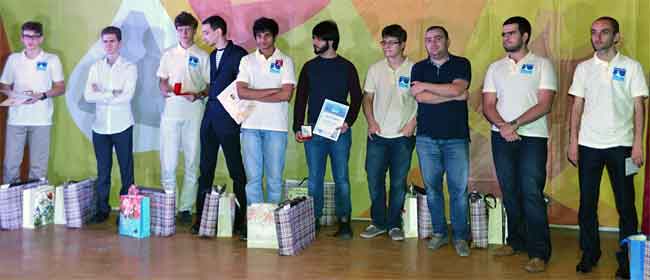
The participants: Jan-Krzysztof Duda, David Anton Guijarro, Vladislav Artemiev, Robert Hovhannisyan, Vidit Gujrathi, Salem Saleh, Samuel Sevian, Tigran Petrosian, Hovhannes Gabuzyan and Samvel Ter-Sahakyan.
The 2014 edition was definitely stronger than this year. In 2014 I was the seventh seed and there were many experienced players like Areshchenko, Melkumyan, Kuzubov and others. This year it was completely different. I was the seeded second. In 2014 I was the youngest and this year five players were younger to me, with Sevian, born in 2000, making me look positively old! The Elo of the participants did not reflect their true playing strength, as all the players are still in their developing phase and will gain many rating points in the time to come. No wonder the event was dubbed as a “Tournament of future stars”.
|
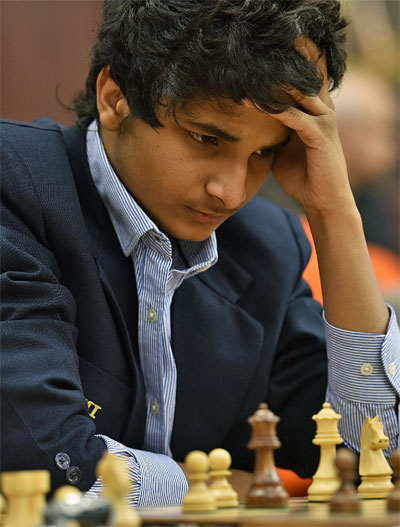
GM Vidit Santosh Gujrathi, Date of Birth: 24 October, 1994, Current Rating 2643
- 2005, 2006, 2007, 2009: Four-time National Youth Champion.
- 2008: Champion of the World U14 Junior Chess Championship.
- 2009: Silver medal holder in the World U16 Junior Chess Championship.
- 2013: Bronze medalist of the World Junior Chess Championship.
- 2014: National Champion in National Challengers Championship.
- 2014: Winner of “Lake Sevan 2014” International Chess Tournament.
From the Lake Sevan tournament web site
|
How does one prepare for an event like this? There are usually two approaches – one is specific opening preparation based on your opponent’s repertoire. If one follows this then he has to prepare with both the colours as the lots are drawn just a day prior to the tournament. The other approach is to go for general preparation trying to improve on your weaknesses without worrying about your opponent’s. I tried to balance between the two. I looked at my opponent’s games before the tournament but didn’t go into any specific preparation based on their openings. I was trying to fix the problems in my own repertoire. It was more general. Besides I hadn’t played a serious tournament for quite some time, so I was mainly concerned with getting into good shape before the tournament.
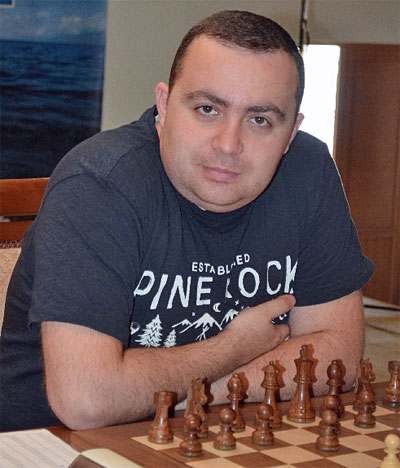
Tigran Petrosian (above) is the trickiest player I know. I have played four blitz games against him and every time I was winning, but in the time pressure he would always trick me with some sneaky moves and win. He doesn’t have a very solid opening repertoire – he plays opening lines where he might be slightly worse but where the position is strategically complex and rich.
In this tournament he was clearly out of shape, yet he beat me and Artemiev, two of the highest rated players in the event. In his game against me I had a clearly better position but as you already must have guessed by now…. he tricked me! I did not play concretely when I held the advantage – I did not force a decision and kept shuffling my pieces in time pressure. What happened next is for you to see.

[Event "Lake Sevan 2015"] [Site "Martuni ARM"] [Date "2015.07.19"] [Round "8.4"] [White "Petrosian, Tigran L"] [Black "Vidit, Santosh Gujrathi"] [Result "1-0"] [ECO "A07"] [WhiteElo "2630"] [BlackElo "2643"] [Annotator "Gujrathi,Vidit"] [PlyCount "85"] [EventDate "2015.07.12"] 1. Nf3 d5 2. g3 Nf6 3. Bg2 g6 4. c4 dxc4 5. Na3 Be6 6. Qc2 Bd5 7. Nxc4 Nc6 8. O-O Bg7 9. d3 Bxf3 $5 10. exf3 Nd4 11. Qd1 O-O {From this point onwards I keep strengthening my position little by little until he has quite a substantial advantage.} 12. f4 c6 13. Bd2 Nd5 14. Ba5 b6 15. Bd2 a5 16. a3 a4 17. Rb1 Nb3 18. h4 Qc7 19. Re1 Rad8 20. h5 b5 21. Ne5 c5 22. hxg6 hxg6 23. Qe2 e6 24. Rbd1 Rd6 25. Bh3 Rfd8 $15 {White's bishop pair are not playing and Black has complete control over the position.} 26. Kh2 Nd4 27. Qe4 Nf6 (27... f5 $1 28. Qg2 Bxe5 29. Rxe5 (29. fxe5 R6d7 $17) 29... Kf7 $17 {with the idea of Rh8.}) 28. Qh1 Nb3 29. Bc3 Nd5 30. Bd2 Nxd2 31. Rxd2 Ne7 32. Rc2 Qb6 33. Qe4 Nf5 ( 33... Bxe5 34. Qxe5 (34. fxe5 Rxd3 $17) 34... Rxd3 35. Qxc5 Qxc5 36. Rxc5 Rd2 $17) 34. Bxf5 exf5 35. Qh1 Rd5 (35... Bxe5 36. Rxe5 Kg7 37. Qf1 Rxd3 $19) 36. Rce2 Qd6 37. Kg1 Qc7 $2 {After not making a decision for many moves, Black goes wrong and immediately gets into a losing position.} 38. Nf3 $1 {The knight is coming to g5 and the rooks are perfectly placed on the e-file.} f6 39. Nh4 $1 Rxd3 (39... Kf7 {Many moves win here but the best is to make space for the queen to come to e4.} 40. g4 $3 fxg4 41. Qe4 $18) 40. Nxg6 Rd1 41. Ne7+ Kf8 42. Qh7 Rxe1+ 43. Rxe1 {and before I knew it I had to throw in the towel.} 1-0
My game against Hovhannisyan gave me unprecedented fame… for the wrong reasons!
Vidit Santosh Gujrathi - Robert Hovhannisyan

I saw that 21.Na5! was winning. I calculated the line (see analysis below), but it was a bit complicated. I wanted to keep things simple. I thought Black doesn’t have any good moves in the position (which is partly true because even Rc2 or Qc2 is a good move). Since I had taken Bxg4, I had the idea of Rh3-g3. I just chose the worst moment to play it. Do you see instantly why?

[Event "Lake Sevan 2015"] [Site "Martuni ARM"] [Date "2015.07.17"] [Round "6.2"] [White "Vidit, Santosh Gujrathi"] [Black "Hovhannisyan, Robert"] [Result "0-1"] [ECO "D43"] [WhiteElo "2643"] [BlackElo "2611"] [Annotator "Gujrathi,Vidit"] [PlyCount "42"] [EventDate "2015.07.12"] 1. d4 d5 2. c4 c6 3. Nf3 Nf6 4. Nc3 e6 5. Bg5 h6 6. Bh4 dxc4 7. e4 g5 8. Bg3 b5 9. Be2 b4 10. Na4 Nxe4 11. Be5 Nf6 12. Rc1 Bg7 13. Nc5 Nbd7 14. Nxd7 Qxd7 15. h4 g4 16. Nd2 Ba6 17. Bxg4 c3 18. bxc3 bxc3 19. Nb3 Qd5 20. Bf3 Qc4 {[%cal Gh1h3] White has many ways to gain a clear advantage here.} 21. Rh3 $4 {The only positive thing that happened after this move is that people started to compare me with Vladimir Kramnik for missing a mate in one (the Russian World Champion had done that in his match against Fritz).} (21. Na5 $1 Qxa2 22. Bxc6+ Ke7 23. Bxa8 Qxa5 (23... Rxa8 24. Nc6+ Kf8 25. Nb4 $18) 24. Ra1 Qb4 25. Qa4 Qxa4 26. Rxa4 Rxa8 27. Rxa6 $16) (21. Be2 Qxe2+ 22. Qxe2 Bxe2 23. Kxe2 $14) ( 21. Rc2 $1 $16) 21... Qf1# {No takeback please! This game was a complete nightmare – after it I couldn’t sleep till four in the morning!} 0-1

What happens on the board stays on the board! Hovhannes Gabuzyan, Vidit and
Robert Hovhannisyan have a light moment together at the closing ceremony.
And how do you come back after such a loss? For me it was sharing the pain with a friend who had been having a torrid event! Salem Saleh had also lost his game that day. So we both were depressed and decided to meet and show our best games to each other. And this helped me to be in a better mood for the next game. I was inspired by looking at Salem’s crazy attacking chess. So in my game with Ter-Sahakyan I decided to roll the dice and complicate the game right from the opening!


[Event "Lake Sevan 2015"] [Site "Martuni ARM"] [Date "2015.07.18"] [Round "7.2"] [White "Ter-Sahakyan, Samvel"] [Black "Vidit, Santosh Gujrathi"] [Result "0-1"] [ECO "C00"] [WhiteElo "2593"] [BlackElo "2643"] [Annotator "Gujrathi,Vidit"] [PlyCount "104"] [EventDate "2015.07.12"] 1. e4 e6 2. d3 {I did not expect this. Samvel had played only the main lines before this game.} d5 3. Nd2 c5 4. Ngf3 Nc6 5. g3 {Here I thought for a few minutes. I was struck by an interesting idea and I decided to go for it.} Nf6 6. Bg2 Be7 7. O-O b6 $5 {My plan was to just wait and develop the queenside and depending upon White's play to castle long or short} 8. Re1 Bb7 9. a3 Qc7 10. Qe2 h6 $5 {I wanted to get this useful move in place. After 0-0-0 I was worried about ideas like e5 followed by c4. Then after Black's d4 I didn't like Ne4 foll by Bf4.} 11. c3 O-O-O $5 12. b4 c4 {I had in my mind this move when I played h6. The position is not new. There are already 16 games being played in it, with White having a 90% score!} 13. dxc4 dxe4 14. Nxe4 $5 (14. Nd4 $1 {would have been very powerful.} Nxd4 (14... Rxd4 {was my original intention when I played c4.} 15. cxd4 Nxd4 16. Qd1 Rd8 17. Nxe4 $1 {But I couldn't find anything concrete for Black after this move.} Nxe4 18. Bxe4 f5 ( 18... Bxe4 19. Rxe4 $16) 19. Bf4 $1 {A strong intermediate move which I had overlooked in my preliminary calculations} (19. Bxb7+ Qxb7 20. Re3 Bg5 21. f4 Bf6 {I thought Black has good compensation.}) 19... Qd7 {and now} (19... e5 20. Bxe5 {:)}) 20. Bd5 $3 {A very strong move which just kills Black's counterplay. }) 15. cxd4 Rxd4 16. Bb2 $1 Rd3 17. Nxe4 Rhd8 18. c5 $1 $16 {White has an overwhelming advantage.}) 14... Nxe4 15. Qxe4 {Here I realised that it is not at all easy for Black to parry White's threats after the queen sacrifice. I was trying to make Na5 and other ideas work, but White is just clearly better.} Nxb4 (15... Nd4 $5 {was another move that I considered} 16. Qxb7+ (16. Qe3 Nc2 $15) (16. Qxd4 Rxd4 17. cxd4 $44) 16... Qxb7 17. Nxd4 Qc7 {Compared to the game White doesn't have the a-file for the rook, but in return he has an extra pawn and tempo. I thought the position was unpleasant to play anyways so I just decided to grab whatever material I can and simply suffer.}) 16. Qxb7+ $1 {A practically very interesting queen sacrifice for just two minor pieces.} ( 16. Bf4 $6 {Engines suggest this, but I was not at all worried about it. I can't imagine Black being in any danger after the resulting position.} Bxe4 17. Bxc7 Nc2 (17... Kxc7 18. axb4 $18) 18. Bxd8 Rxd8 19. Nd4 Bh7 20. Nxc2 Bxc2 $44) 16... Qxb7 17. axb4 Qc7 18. Bf4 {I was a bit surprised by this move. I was mainly considering Ne5 and Nd4} (18. Ne5 Bg5 $1 {This was the point. It is important to provoke f4 and then go Bf6, as White doesn't have the option of Bf4 now.} 19. Nc6 Rd7 20. c5 $1 {The position is totally messy, but I think Black should be okay.} bxc5 21. bxc5 Rhd8 {is one way to play}) (18. Nd4 $1 Rxd4 $1 {I am pretty sure I would have played this immediately.} (18... Qxc4 { I was trying to make this work during the game.} 19. Nc6 Bf6 (19... Rd7 20. Nxa7+ Kc7 21. Bf4+ Bd6 22. Bf1 $1 $18 {just kills Black's idea.}) 20. Rxa7 Rd5 $1 21. b5 $1 $16 {But after this strong move I think White is clearly better.}) 19. cxd4 Bxb4 20. Bf4 Qe7 21. Reb1 Bc3 $1 {and now there is a funny perpetual.} 22. Rxb6 $1 axb6 23. Ra8+ Kd7 24. Ra7+ Kd8 25. Ra8+ Kd7 $11) 18... Bd6 19. Be3 $6 {This looked too artificial to me. Now Black has enough time to co-ordinate his rooks. White should have played energetically with Ne5.} (19. Ne5 $1 {The knight is jumping to c6 but eliminating it leaves White with two strong bishops.} g5 (19... f6 20. Nc6 $14) (19... Bxe5 20. Bxe5 Qd7 21. c5 $1 $16) 20. Nc6 gxf4 21. Rxa7 fxg3 $1 22. hxg3 Qxa7 23. Nxa7+ Kd7 $11 {and the game is surprisingly balanced.}) 19... Rd7 20. Nd2 $2 {I simply don't understand this. I was only calculating Nd4 with some jumps} (20. Nd4 Qxc4 21. Bf1 Qc7 22. Nb5 Qb8 23. Ra6 $1 Re8 $1 24. Rea1 Ree7 $15 {and now funnily enough, Black's next moves are Kd8-e8-f8}) 20... Be5 $17 21. Rec1 Rhd8 22. Nf3 Rd3 23. c5 Rxe3 $1 { I could finally relax after this.} 24. fxe3 bxc5 25. b5 Bf6 26. Ra2 Rd3 27. Ra6 Rd6 28. Raa1 Kb8 29. Ra2 Qd7 30. Rcc2 Rb6 $2 {Too passive. I should have tried to finish off the game immediately by active play.} (30... Rd1+ 31. Kf2 Qd3 $19 ) 31. c4 Rd6 32. Kf2 Qc7 33. Nd2 Rd3 34. Ke2 {After my chicken-like play in time trouble, I already started to feel a bit uneasy. White has slowly co-ordinated all his pieces.} Rc3 $1 35. Ne4 Rxc2+ 36. Rxc2 Be5 37. Ra2 f5 38. Nf2 a5 $1 {A very important move. Otherwise White would just play Ra6 Nd3 with lot of threats.} 39. bxa6 Ka7 40. Nd3 Bc3 $19 {Now there are various ways to win.} 41. Ra3 Bb4 42. Ra2 g5 43. Bb7 h5 44. Ra1 h4 45. Kf2 h3 46. Bf3 Qg7 47. Rc1 Kxa6 48. Be2 Kb6 49. Bf1 g4 50. Be2 Qb7 51. Nf4 Qe4 52. Rd1 Kc7 0-1
The idea of 0-0-0 was very risky and after the game Petrosian told me that this queen sacrifice with Qxb7 is almost winning for White. Of course both Samvel and I were out of our preparation, probably as early as move nine. I leave you readers with the opportunity to check whether Petrosian’s words are true – or was he tricking me once again!?
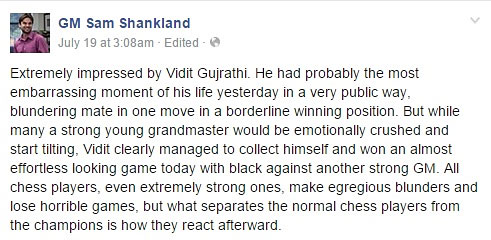
Vidit’s coming back with a win after a tragic mate in one was quite an inspiring story
and many top players echoed that emotion, like Sam Shankland on facebook
Cross table at the end of seven rounds

– Part two of this article to follow soon –
The tournament standings and interview with the winner can be in our previous report.
